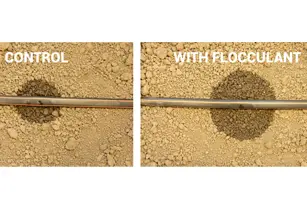As natural resource, water is increasingly becoming more precious, especially in agriculture. Improving water usage efficiency in irrigated systems is an important objective
Underground drip irrigation increases 70 per cent water efficiency compared to traditional surface gravity furrow irrigation. This high-performance irrigation method provides water savings that can reach 70 per cent.
This process can be further improved upon by increasing the irrigation bulb size with SNF’s new agricultural flocculant. SNF has developed an agricultural flocculant that increases the irrigation bulb size, reduces percolation water losses providing better water usage by the plants.
Soil humidification is vital to underground drip irrigation improvements
Bringing water as close as possible to the roots of a plant is a major parameter to the efficiency of irrigation water. Improving water localisation diminishes percolation losses and increases irrigation bulb size.
Water conscious producers all implement one strategy or another to improve their water efficiency. One such method is to increase the number of drips. However, this approach is sometimes too expensive to be a good business strategy. Increasing the quantity of irrigation water unfortunately systematically implies increasing percolation losses. These two methods have their merits but are not the best.
Ideally, increasing wet-bulb size with the same quality of water provides a better and more uniform water distribution in the soil, increasing water availability for the plant, without increasing costs in equipment and without increasing water losses. This will ensure a better root system development and improve fertiliser usage.
 An agricultural flocculant improves water availability for plants
An agricultural flocculant improves water availability for plants
A new agricultural flocculant has been used in the US since 2018 to improve the size of irrigation wet bulbs. This flocculant, available in liquid form, easily dissolved, is simply applied through the surface or subsurface drip irrigation system. It improves soil humidity and water localisation in the soil. By improving soil-humidity and water homogeneity it also improves water availability for the plants and limits percolation losses (Photo 1).
Trials have been made by the University of Georgia, the USA in 2018. They have shown a significant increase in Chili Pepper production compared to a blank test using the same quantity of water and fertiliser (Photo 2). By using an agricultural flocculant in underground drip-irrigation it becomes now possible for a producer to invest in low water consumption techniques in regions where this resource is rare.

An agricultural flocculant improves germination and limits fertiliser leaching
In addition to water savings, the flocculant acts on aggregate stabilisation and reinforces the soils agronomic properties. During germination, water availability is increased within the irrigation wet bulb and seed growth is homogeneous. During the growth period, stable aggregates maintain water and fertilizers in the soil preventing leaching.
Water-saving techniques in agriculture are sought after because, as a resource, water is increasingly tight in supply. It is important to identify new and useful techniques invented abroad to answer tomorrows challenges.







